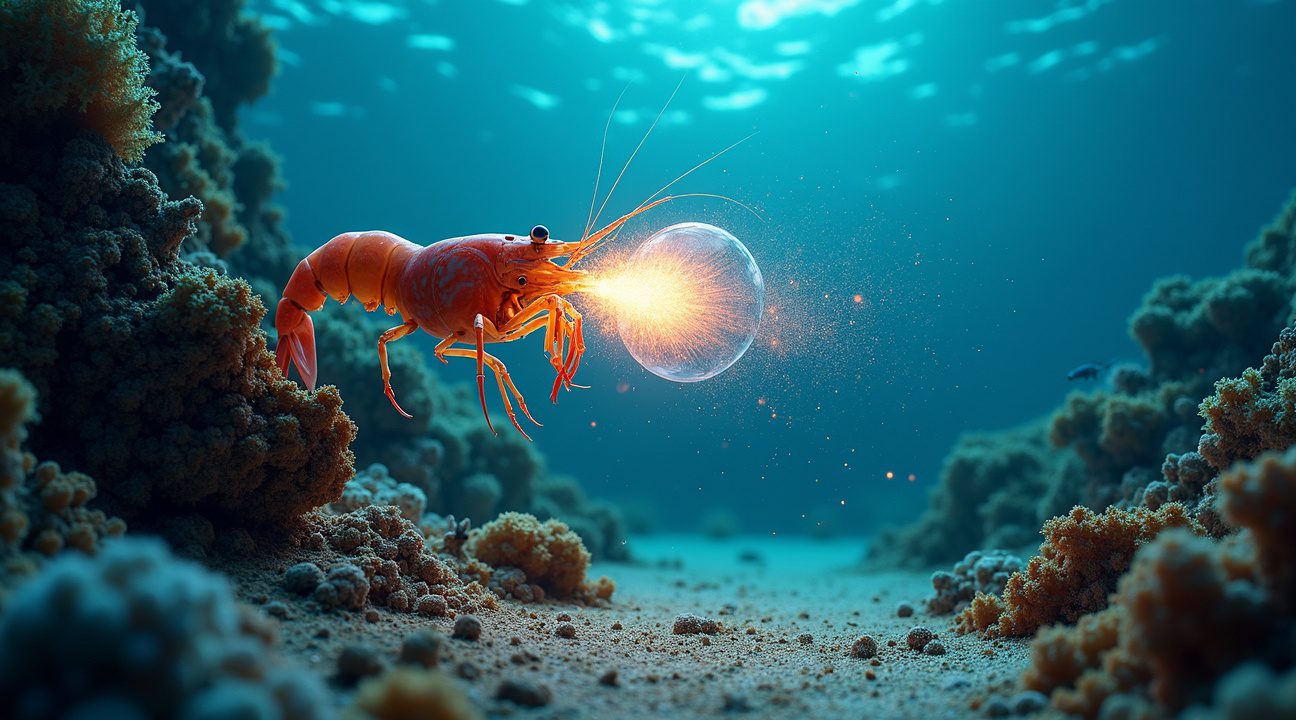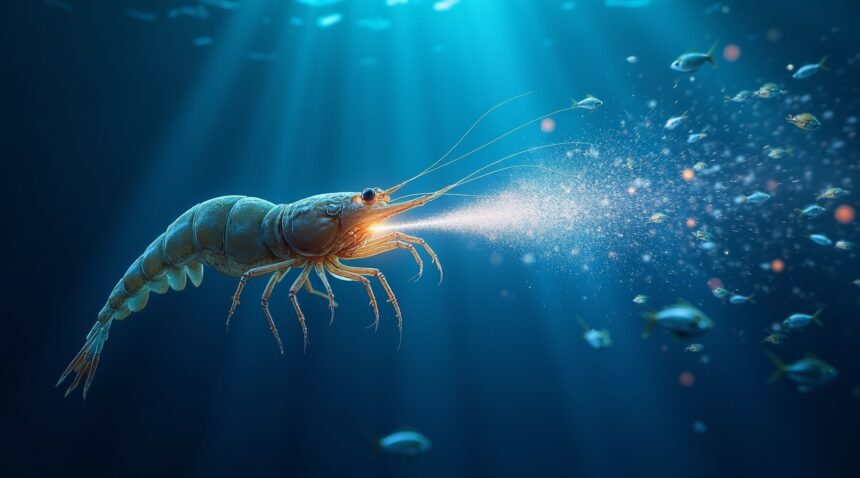The pistol shrimp, though only 2 centimeters long, produces an astonishing underwater sound between 210 to 230 decibels using a specialized claw mechanism that generates cavitation bubbles—making it the loudest animal on Earth relative to its size.
Key Takeaways
- The pistol shrimp produces 210-230 decibel sounds using rapid claw closure that creates cavitation bubbles, which collapse and generate temperatures comparable to the sun’s surface.
- Despite its miniature size of just 2 centimeters, this crustacean surpasses much larger animals, including blue whales (188 dB), lions (114 dB), and elephants (117 dB) in sound production.
- The acoustic snap fulfills several biological functions, such as stunning prey, territorial defense, and communication, enabling the shrimp to kill small fish and crustaceans instantaneously.
- The sound follows a logarithmic decibel scale, underscoring the shrimp’s massive acoustic output as a remarkable feat for such a tiny organism.
- This trait reflects an extraordinary evolutionary adaptation, where a sophisticated biological mechanism produces unmatched power-to-size efficiency within the animal kingdom.
For more insight into the fascinating world of this creature, visit the Wikipedia page on pistol shrimp.
A 2-Centimeter Marine Creature Produces Earth’s Loudest Sound
The pistol shrimp, scientifically classified within the family Alpheidae, defies all expectations about size and sound production. This remarkable crustacean stretches just 2 centimeters in length, yet it creates acoustic phenomena that put much larger animals to shame. Marine biologists have documented this tiny creature’s ability to generate sounds reaching 210 to 230 decibels underwater, placing it among the loudest animals on our planet.
How Such a Small Creature Creates Deafening Sounds
The pistol shrimp’s extraordinary sound production stems from its specialized claw mechanism. When the shrimp snaps its oversized claw shut at incredible speed, it creates a cavitation bubble in the water. This bubble collapses almost instantaneously, producing the intense sound that can travel significant distances through marine environments. The process happens so rapidly that it generates temperatures comparable to the surface of the sun for a brief moment.
Comparing the Pistol Shrimp’s Volume to Familiar Sounds
To put this creature’s acoustic power into perspective, its 210 to 230-decibel output surpasses many sounds we consider extremely loud:
- A gunshot typically registers around 140 to 180 decibels
- A jet engine produces approximately 130 to 160 decibels
- Even blue whales, the largest animals on Earth, generate calls that reach only about 188 decibels
The pistol shrimp’s sound production becomes even more impressive when considering that decibels follow a logarithmic scale, meaning each 10-decibel increase represents a tenfold increase in sound intensity.
This snapping mechanism serves multiple purposes beyond creating impressive acoustic displays. The shrimp uses its sound-producing ability to:
- Stun prey
- Communicate with other shrimp
- Defend territory
The cavitation bubble’s collapse creates a shockwave powerful enough to kill small fish and crustaceans within close range. Scientists have observed that the bubble’s collapse also produces a brief flash of light, adding a visual component to this already extraordinary phenomenon.
The pistol shrimp’s acoustic abilities have captured the attention of researchers studying bio-acoustics and marine communication. Unlike many loud animals that rely on size or specialized vocal organs, this tiny crustacean achieves its remarkable volume through pure mechanical engineering. Its claw design represents millions of years of evolutionary refinement, creating one of nature’s most efficient sound-producing mechanisms in an incredibly compact package.
The Physics Behind the Explosive Snap
The pistol shrimp’s sound production relies on one of nature’s most fascinating physical phenomena. When this tiny crustacean rapidly closes its oversized claw, it doesn’t simply clap two surfaces together like applauding hands. Instead, the specialized anatomy creates a high-velocity water jet that triggers an extraordinary chain reaction.
Cavitation: Nature’s Sonic Weapon
The rapid claw closure forces water through a small gap at incredible speeds, creating an area of extremely low pressure behind the water jet. This pressure drop causes water molecules to instantly vaporize, forming a bubble in a process scientists call cavitation. The bubble grows rapidly but remains unstable, lasting only microseconds before violently collapsing back in on itself.
During this collapse, the bubble generates the explosive sound that makes this diminutive creature the ocean’s loudest inhabitant. The implosion creates a shockwave powerful enough to stun small fish and crabs, allowing the shrimp to capture prey without even touching it. This biological weapon system proves that size doesn’t always determine impact, much like how researchers find deep-sea creatures can possess remarkable adaptations despite extreme conditions.
Extreme Temperatures in Miniature
The physics becomes even more remarkable when examining what happens inside the collapsing bubble. As the cavitation bubble implodes, it generates temperatures reaching approximately 4,400°C. This temperature rivals the surface of the sun, creating a brief but intense hotspot in the surrounding water. The extreme heat lasts only nanoseconds, but it’s sufficient to produce a flash of light called sonoluminescence.
Scientists measure the pistol shrimp’s snap at around 210 decibels, making it louder than a gunshot or jet engine. The sound travels efficiently through water, which conducts acoustic waves much better than air. This efficiency explains why the shrimp’s snap can be heard over considerable distances underwater, and why it poses such an effective hunting strategy.
The entire process happens faster than the human eye can perceive. From the initial claw snap to the bubble collapse and resulting shockwave, the sequence completes in less than a millisecond. This rapid-fire mechanism allows the shrimp to hunt repeatedly without exhausting itself, making it one of the ocean’s most efficient predators despite its small stature.
Understanding this natural phenomenon has inspired researchers to explore applications in various fields, from medical treatments using focused sound waves to engineering solutions for underwater communication systems. The pistol shrimp demonstrates how evolution can produce incredibly sophisticated mechanisms in surprisingly small packages, proving that acoustic power doesn’t require massive size or complex vocal cords.
How the Pistol Shrimp Outroars Lions, Elephants, and Jets
I find it remarkable that a tiny 2-centimeter crustacean produces sounds that dwarf the acoustic output of nature’s most famously loud creatures. The pistol shrimp generates an astounding 210 to 230 decibels with each snap of its specialized claw, creating one of the most intense sounds in the animal kingdom.
Land Giants Can’t Compete
When comparing the pistol shrimp’s acoustic prowess to terrestrial animals, the difference becomes striking. Lions, those iconic symbols of raw power, produce roars that reach only 114 decibels—nearly half the intensity of this diminutive marine animal. Elephants, despite their massive size and trunk amplification system, generate calls that peak at 117 decibels. Even the aptly named howler monkey, renowned for its ear-piercing vocalizations that can travel for miles through dense rainforest, maxes out at 128 decibels.
These comparisons highlight an extraordinary fact about nature’s acoustic hierarchy. Size doesn’t always correlate with sound production capability. The pistol shrimp’s hunting mechanism generates more decibels than a jet engine at takeoff, which typically measures around 130-140 decibels. This tiny creature literally outperforms some of humanity’s loudest mechanical creations while fitting comfortably in the palm of your hand.
Marine Competition Remains Limited
In aquatic environments, few animals can challenge the pistol shrimp’s acoustic dominance. Sperm whales represent the closest competition, producing echolocation clicks that peak between 230-233 decibels. However, this comparison underscores the pistol shrimp’s truly exceptional nature—sperm whales can grow up to 60 feet long and weigh as much as 45 tons, making them roughly 3,000 times larger than their tiny competitor.
The sound-to-size ratio makes the pistol shrimp’s achievement even more impressive. While researchers find fascinating creatures throughout ocean depths, none match this crustacean’s acoustic efficiency. Marine biologists continue studying how such a small animal generates sounds that exceed those produced by creatures thousands of times its size.
Understanding the pistol shrimp’s capabilities puts other animal sounds into perspective. Blue whales, the largest animals on Earth, produce calls that reach approximately 188 decibels, yet even these ocean giants fall short of the pistol shrimp’s output. Dolphins and other toothed whales generate clicks and whistles in the 160-200 decibel range, impressive for communication and echolocation but still quieter than our tiny champion.
The pistol shrimp’s acoustic supremacy extends beyond mere volume measurements. The speed and precision of its claw closure create a cavitation bubble that collapses with such force that it briefly reaches temperatures comparable to the sun’s surface. This incredible phenomenon demonstrates how evolution can produce extraordinary adaptations in the most unexpected packages.
Military sonar systems, designed specifically for long-range underwater detection, typically operate at 180-220 decibels. The fact that a 2-centimeter prawn naturally produces sounds in this range showcases the remarkable engineering solutions that millions of years of evolution can create. Evolution and intelligence manifest in countless surprising ways throughout marine ecosystems.
Scientists continue researching applications for the pistol shrimp’s acoustic principles in human technology. The efficiency of its sound production mechanism offers insights for developing new underwater communication systems and acoustic devices. This research demonstrates how studying nature’s most extreme examples can lead to technological breakthroughs that benefit human society.
The pistol shrimp’s dominance in the acoustic arena proves that nature’s most impressive achievements often come in the smallest packages, challenging our assumptions about size, power, and capability.
https://www.youtube.com/watch?v=IOW1RZb4RIC

Hunting and Defense Through Sound Weaponry
The pistol shrimp’s acoustic snap functions as both a deadly hunting tool and an effective defense mechanism. This tiny crustacean has evolved one of nature’s most sophisticated sound-based weapons, capable of generating powerful shockwaves that can instantly disable or kill small marine animals like fish and crabs.
Precision Targeting for Prey Capture
I find it remarkable how the pistol shrimp employs its acoustic weapon with surgical precision. The creature positions itself strategically before unleashing its devastating snap, creating a focused shockwave that travels through the water at incredible speeds. This technique proves highly effective against small fish, juvenile crabs, and other marine invertebrates that venture too close to the shrimp’s territory. The impact from the acoustic blast can stun prey instantly, making capture effortless for the diminutive predator.
The hunting strategy relies on timing and accuracy rather than brute force. While studying these fascinating creatures, researchers have observed how the shrimp waits patiently for the perfect moment to strike. The acoustic blast creates a cavitation bubble that collapses with tremendous force, generating temperatures that briefly reach levels comparable to the sun’s surface. This extreme heat and pressure combination creates an environment so hostile that few small marine creatures can survive the encounter.
Defensive Applications and Human Safety
Beyond hunting, the pistol shrimp’s sound weaponry serves as an excellent deterrent against larger predators. The acoustic snap can startle potential threats and signal the shrimp’s readiness to defend its territory. Interestingly, the sound operates at frequencies that often extend beyond human hearing capabilities, which means this powerful acoustic weapon doesn’t pose any threat to human divers or marine researchers.
The frequency range of the pistol shrimp’s snap typically falls between 2–10 kHz, though some components extend higher. This acoustic signature allows the creature to communicate with others of its species while simultaneously serving its predatory and defensive purposes. Unlike the world’s deadliest bird, which relies on physical attacks, the pistol shrimp’s approach represents a more refined evolutionary solution to survival challenges.
Marine biologists continue studying how these remarkable creatures coordinate their acoustic attacks and whether they can adjust the intensity based on target size. The precision and effectiveness of this natural sound weapon system offers insights into how evolution has shaped some of nature’s most unexpected predators.

The Remarkable Evolutionary Achievement of Acoustic Dominance
The pistol shrimp’s sonic snap represents one of nature’s most impressive evolutionary breakthroughs, demonstrating how biological systems can achieve extraordinary physical feats. I find it fascinating that this tiny crustacean has developed a specialized claw mechanism that generates sound levels rivaling mechanical sonic booms, reaching intensities that would be impossible for most animals to produce through conventional means.
Evolutionary Adaptations for Predatory Success
Evolution has equipped the pistol shrimp with remarkable features that compensate for its diminutive size. The specialized claw operates through rapid closure, creating cavitation bubbles that collapse with tremendous force. This mechanism allows the shrimp to stun or kill prey instantly, turning its small stature into a strategic advantage rather than a limitation. Unlike larger predators that rely on physical strength, the pistol shrimp harnesses physics to dominate its hunting territory.
The acoustic weapon serves multiple purposes beyond simple predation. The shrimp uses these powerful snaps for territorial defense, communication with potential mates, and establishing dominance within its habitat. Each snap produces temperatures comparable to the sun’s surface for microseconds, creating a biological phenomenon that rivals sophisticated human-engineered systems in both complexity and effectiveness.
Ecosystem Engineering and Marine Influence
Beyond its acoustic abilities, the pistol shrimp demonstrates remarkable ecosystem engineering skills through burrow construction and symbiotic partnerships. These creatures excavate extensive tunnel systems that provide shelter for various marine species, fundamentally altering the seafloor structure in their territories. The burrows create microhabitats that support biodiversity, much like how deep-sea environments harbor unique species adaptations.
The shrimp often forms cleaning partnerships with gobies, creating mutually beneficial relationships that enhance survival for both species. The goby acts as a lookout while the nearly blind shrimp maintains their shared burrow, demonstrating how acoustic dominance extends beyond hunting into complex social behaviors. These partnerships influence local marine ecosystems by creating stability zones where multiple species can thrive, proving that the pistol shrimp’s impact extends far beyond its impressive sound production capabilities.

Where Other Earth’s Loudest Animals Fall Short
Several creatures across different habitats have earned reputations for their impressive vocal abilities, yet none can match the acoustic power-to-size ratio of the tiny pistol shrimp. The sperm whale produces sounds reaching up to 233 dB when hunting in deep ocean waters, making it one of the most powerful sound generators on the planet. These massive marine mammals use echolocation clicks that can travel for miles through the ocean depths, similar to how deep-sea fish have adapted to extreme environments.
Flying mammals also contribute to nature’s symphony with the greater bulldog bat reaching up to 140 dB during its hunting calls. These nocturnal predators rely on sophisticated echolocation systems to navigate and capture prey in complete darkness. On land, the green grocer cicada produces sounds up to 135 dB during mating season, creating the characteristic buzzing that fills summer evenings across many regions.
Size Versus Sound Production
Primates add their voices to nature’s chorus, with howler monkeys generating calls that reach 128 dB and can be heard up to three miles away through dense rainforest canopies. These territorial displays serve as long-distance communication between troops and help establish dominance without physical confrontation. Even dangerous birds produce impressive vocalizations for territory defense.
What sets the pistol shrimp apart from these acoustic champions isn’t necessarily the raw decibel output, but rather the remarkable disproportion between its miniature 2-centimeter body and its 200+ dB snap. A sperm whale weighs approximately 40 tons and stretches up to 60 feet in length, making its powerful calls proportionally reasonable. Howler monkeys possess specialized throat structures and enlarged hyoid bones that enable their loud vocalizations, while cicadas use specialized organs called tymbals to amplify their mating calls.
The pistol shrimp achieves its acoustic feat through a completely different mechanism – cavitation bubble collapse rather than traditional vocal structures. This biological innovation allows a creature smaller than a human thumb to produce sounds comparable to a gunshot or jet engine. Marine ecosystems continue to reveal such extraordinary adaptations, much like how blue whales have developed their own unique communication methods.
While other animals certainly produce impressive sounds through various biological mechanisms, none achieve the pistol shrimp’s extraordinary acoustic power relative to body size. This tiny crustacean demonstrates that in nature, size doesn’t always determine capability, and some of the most remarkable abilities come in surprisingly small packages.

Sources:
IFAW Journal: “These are the loudest animals on Earth”
Biozoomer: “Facts Of Animal World”
HowStuffWorks: “20 of the Loudest Animals on Earth”
Audiology.org: “The Loudest Animals in the World”
Hush City Soundproofing: “Top 10 Loudest Animals”
Hidden Hearing: “The Top Ten Loudest Animals In The World”


